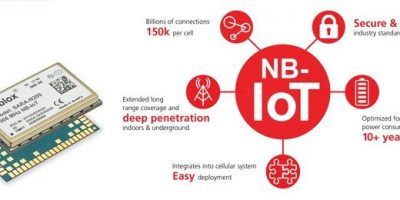First cellular NB-IoT module ensures connectivity and over 10 years’ battery life
Claimed to be the world’s first cellular radio module compliant to the 3GPP Release 13, Narrowband IoT (NB-IoT) LTE Cat. NB1 standard, the Sara-N2 NB-IoT module has been announced by u-blox.
The module is designed for use in smart buildings and cities, utilities metering, white goods, asset tracking, and agricultural and environmental monitoring. It will operate for between 10 and 20 years from a single-cell primary battery. Its 16 x 26mm LGA form factor, and the company’s nested architecture, allows for simple upgrades from the company’s GSM, HSPA or CDMA modules and is also claimed to ensure future-proof, seamless mechanical scalability across technologies.
The module provides secure, private communications over licensed spectrum with guaranteed quality of service. It supports peak downlink rates of up to 227kbit/s and uplink rates of up to 21kbit/s. Simultaneous support for three RF bands means that the same module may be used in most geographic regions.
NB-IoT has advantages over other cellular radio technologies, such as lower device complexity, low power operation and support for up to 150,000 devices per single cellular cell. It also offers a 20dB link budget improvement over GPRS, for poor coverage conditions such as underground or inside buildings.
It offers greater security and freedom from interference than unlicensed spectrum Low Power Wide Area (LPWA), as it uses a licensed spectrum based network. Other advantages, says the company, include lower latency than mesh networks, thanks to its point-to-point topology, the ability to run it adjacent to existing 2G and LTE networks (it needs just 200kHz of bandwidth) and a higher transmit power limit, which improves reliability and range. It also allows for robust two-way communication which means that features such as firmware upgrade over the air are achievable. Global roaming is possible, which is not the case with localised, unlicensed spectrum based technologies.
Samples are currently scheduled for Q4 2016, with full production planned for early 2017.




